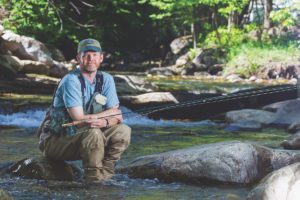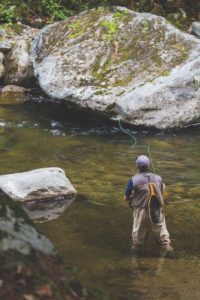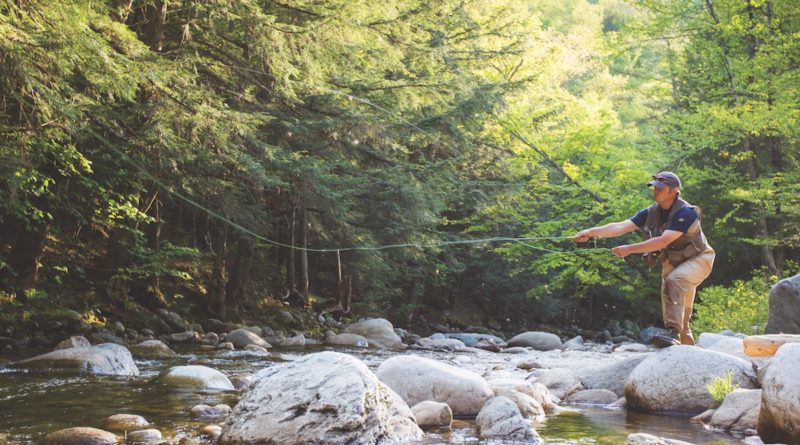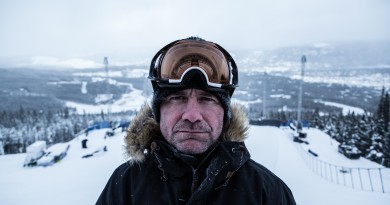Backcountry Brooks
If you want to catch Vermont’s wild trout, head for the hills
By Kirk Kardashian | Photos by Justin Cash
Look with a jaundiced eye at trout fishing in the East, and you’ll see an experience orchestrated to match every angler’s wildest dream. In that dream, every fish is big and stupid. It gulps dry flies from the surface of the water with an almost reckless abandon, and then acts surprised when it realizes there’s a hook in its lip. With a natural drama, the fish runs downstream, upstream, does somersaults in the air. And when you’re just about ready to net the beast, it gets tired and moseys over to you like a cow who knows it’s time for milking. You reach down and heave the trout from the water, admire its reds, greens and yellows, its black spots and generous girth, smile for the camera, and do it again.
I call this an “orchestrated” experience because, sometimes, that’s what it is. At least in Vermont, where I fish. Here, the state Department of Fish and Wildlife (DFW) has a “trophy stocking” program where fisheries biologists raise rainbows and browns in hatcheries — open ponds and concrete raceways — for two years, fattening them up to 20 or more inches, and then drive them in a flat-bed truck with an aerated tank to seven rivers around the state. DFW is even kind enough to post the times and places they’ll be stocking, and keen anglers show up just as the disoriented cast of bruised, domesticated trout get in position. You can almost imagine the director of this production calling the shots from the river bank: And…cue the trophy fish! OK, cue the anglers! Commence casting! Fish, lurk in the slack water and take occasional sips. Now, bite the dry flies! And…that’s a wrap!
This, of course, is a crude caricature of reality. There are plenty of rivers in Vermont with wild trout. It’s just that most anglers ignore them.
But not Ron Rhodes. Rhodes, a River Steward for the Connecticut River Conservancy, likes to fish for wild brook trout on small streams. He’s probably the only angler I know who’s perfectly happy catching 8-inch brook trout all day long.

Brook trout need clean, cold water to survive, and the White River watershed has some of the cleanest, coldest brooks in the state. A few friends and I wanted to see if we’d get hooked on the small fries, too, and Rhodes agreed to show us some of his haunts.
On a hot day in the last week of May, with azure skies and cottony cumulus clouds lording over fully bloomed forests, we pile into my minivan in Woodstock and drive to Royalton to meet Rhodes. It’s me, Justin Cash (a photographer) and Chris Danforth (a former marketing guy for Killington resort). Our fourth — Justin’s longtime friend John Bergman — is up here from Manhattan, getting some R and R from his stressful job on Wall Street.
We’re all accustomed to fishing for rainbows and browns — Danforth has a picture of himself with a 24-inch trophy brown trout on his Facebook page — so this expedition is adding some jazz to an otherwise monotonous fishing season.
It’s also sharpening our vocabulary. What, after all, is the difference between a brook, a stream and a creek? En route to at least one of these classes of waterways, the question suddenly becomes pertinent.
“I scoured the internet,” Cash says, “and came up with nothing!”
Then Bergman adds to the confusion: “And what’s the difference between a creek and a spring creek?” he asks.
Cash is happy to educate him. “A spring creek is a creek fed by a spring,” he says.
“Really?” Bergman responds. “Because I thought it was a creek that filled up in the spring and dried up in the fall.”
The Oxford American Dictionary settles it: a brook is a small stream; a stream is small river, and “creek” is synonym for a brook or a stream. A spring creek, Rhodes points out later in the day, is a slow, flat watercourse fed by subterranean aquifers.
Between Woodstock and Royalton are two sizeable hills, each with brooks creasing their many folds. To go from one town to the other is to enter a different watershed, though few people think of geography in these terms. True, all water does flow downhill to the ocean, but on the way it travels through a landscape of towns, schools, roads, gas stations, forests, parking lots and fields. The flavor of that landscape seasons the water in the watershed. If the landscape tastes like oil and coolant that drips onto asphalt parking lots, so, to a certain degree, will the water. The White River watershed is one of the freshest-tasting in the state because the landscape there is mostly undeveloped.
Still, even the White River no longer holds brook trout, Vermont’s only native stream-dwelling trout. In fact, only two bona fide rivers in the state — the Battenkill and the Castleton — contain brook trout, and that’s because they’re spring fed and therefore stay cool enough to harbor them. But this wasn’t always the case.
Two hundred years ago, all the fish in rivers and brooks were either brook trout or varieties of Atlantic salmon. What happened? Well, to put it simply, the Industrial Revolution. In Vermont, that movement took the form of clear-cut forests, saw mills and, later on, pollution from dairies, canneries, tanneries and slaughterhouses.
The fisheries became so depleted that the state started stocking rainbow trout from California in the 1880s and brown trout from Germany in the 1890s. These fish were heartier and could survive in rivers that reached temperatures of 80 degrees. They also had the effect of elbowing brook trout out of smaller rivers where the food supply was more limited. Environmental regulations cleaned up the rivers, but the lack of shade along the banks has made the larger bodies of water too warm. So, the brook trout retreated to their current neighborhoods, in tree-covered upland streams and brooks above 1,000 feet.
Rhodes, a tall, slim guy with a close-cropped beard, meets us in Royalton and pulls out his Gazetteer, a topographic map with roads and natural features. When he’s prospecting for brook trout, he looks for thin blue lines that bisect closely spaced contours — in other words, waters with some quick elevation loss. These brooks descend small valleys in hundreds of plunge pools. The pools create slow water behind boulders, and that, Rhodes says, is where the fish like to hang out. “The road is also a concern,” he adds. “You want to find a dirt road or a logging road, because they’re even shadier than the paved roads.”
We follow Rhodes eight or ten miles north to Chelsea, situated at the bottom of the many hills that rise in all directions. Passing the white, Colonial-style courthouse and town clerk’s office, we turn onto a side road. As we suit up in our waders, Rhodes gives us some preliminary advice. “If I’m brook trout fishing,” he says, “my number one fly is the elk-hair caddis; a size 12 or 14. That’s because the caddis hatch in the slow water, where the fish are.”

Danforth, a Colorado native who’s had the entire month of May off to fish for big stocked trout, wants to know what we can expect in the size department. “Any chance of catching something in the 16-inch range?” he asks timidly, afraid of the answer.
“The best you can hope for is 12-inches around here,” Rhodes says, explaining that these streams have less space and less food than rivers, so the fish grow accordingly. Plus, this is a harsher environment for trout — they live maybe five years.
On the other hand, Rhodes offers, “brook trout aren’t the pickiest fish, because they can’t afford to be.” They need food and are liable to strike at something that looks appetizing. But in no case will they take a fly dragging down the water; here, as in most rivers, it’s all about line management.
We scramble down a bank into the brook, which is about 10- or 15-feet wide, with big boulders scattered among smaller rocks and pools. We’re all using some variation of 3-weight rod, seven or eight feet in length. You could go much smaller — a zero-weight, for instance, would work — but none of us has procured such an animal.
On the bank, below a paved road still shady enough for Rhodes’ liking, Rhodes takes Danforth’s rod and gives him a few pointers. There are two kinds of small-stream fisherman, he explains: those who hide behind rocks and make longer casts, so as not to spook the fish, and those who walk right up to a hole and keep every possible inch of line out of the water, to have the cleanest presentation.
The former method is good for its element of stealth, but a longer cast in these tight quarters is more likely to get hung up on something. Rhodes is a close-to-the-hole guy. He casts upstream, keeps his rod tip high and lets the fly float down the brook toward the fish. This proves effective: on his first cast, after walking right through a deep pool, Rhodes hooks into an eager brook trout. We all take that as a good sign.
And it is, because shortly after we split up and stake out our positions on the water, we each catch fish ranging from four to nine inches. Now, those numbers would be laughable anywhere else, but here it feels right. The water is small, and so are the fish. They don’t hit like bulls, but it’s fun to watch them dart up to a fly as big as their head and try to ingest it. And the setting is perfect for impatient fishermen: you make five or six casts, hitting all sides of a hole, then move on to the next one. You can fish a single stream for hours this way, slowly working your way up and up, looking for that next little pool, that next perfect boulder. Come back next year and, because of the force of ice and snow melt, the stream will have changed. “A boulder that you or I couldn’t begin to move will be twenty feet downstream,” Rhodes says. “Your favorite hole might be gone, and you’ve got to find a new one.”
An hour or two later, after walking up this stream that wends behind some classic Vermont farmhouses — cobbled together, strewn with junk — we drive to another location, this time on a dirt road. The brook is steeper, darker, more primeval. Big tree trunks cross it like random matchsticks. Glassy pools spill over mossy ledges. The sound of the cascading water is only broken by the occasional rumble of a vehicle on the road, or a crow screeching at us. We pull a few tiny brook trout out — Cash nearly smacks himself in the face with a 2-incher after setting the hook a little zealously — and are ready to call it a day.
Back in South Royalton, at a bar called Crossroads, we sip PBRs on the deck and watch the comings and goings of the sedate town. Brick storefronts — a co-op food market, a deli, a hair salon — face the gazebo on the green. We remark how the day opened our eyes to the possibilities for fishing in places you wouldn’t describe as much more than a ditch. Danforth isn’t about to leave his porno fish. I’m thinking about getting a zero-weight rod.





Pingback: Read the Summer Issue! – VT SKI + RIDE